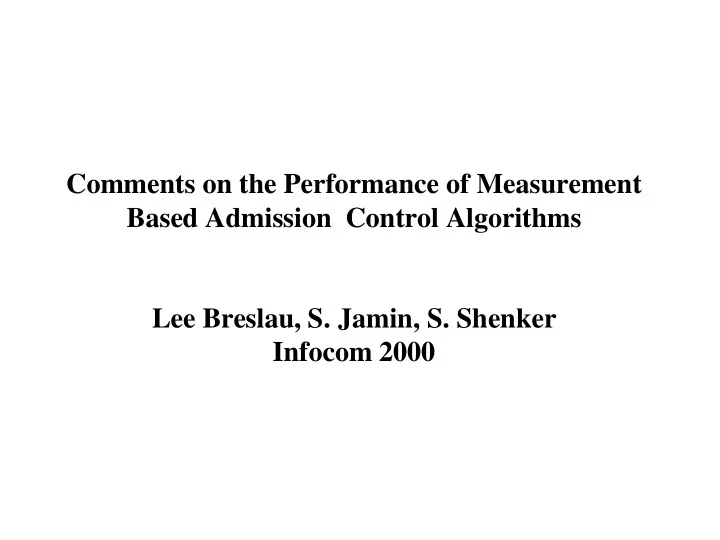

Comments on the Performance of Measurement Based Admission Control Algorithms Lee Breslau, S. Jamin, S. Shenker Infocom 2000
Survey of Measmt Based AC Schemes Many different varieties of MBACs : • Some based on “solid” math models (eg, theory of large deviations) • Others “ad hoc” (no theory underpinning) • Different load estimations: from simple point estimate, to exp averaging , combined mean and variance measmts, etc How to compare them? • Use packet loss as measure of service failure • Loss-load curve : loss rate occurring at given level of service utilization
The Ingredients of MBAC Two key components : • Network load measurements (on aggregate rather than per flow) • Adm control decision based on load measmt
Service Characterization Service requested by appl: • defined by token bucket params – token rate r , bucket depth b Service delivered: • Measured in terms of packet drop rate
MBACs surveyed Measured Sum : • Token rate of new flow + aggregate measured rate of existing flows must be less than utilization threshold “Hoeffding” bounds : • Peak rate of new flow + aggregate equiv bdw of existing flows must be less than link bdw Tangent of equiv bdw curve : • A given “function” of equiv bdw less than link bdw Measure CAC : • Peak rate of new flow + “large deviation” equiv bdw estimate less than link bdw Aggregate Traffic Envelopes, etc
Meas.mts vs Parameter Adm Control Parameter based Adm Control: • Hard real time services • decision based on worst case bounds • typically, low network utilization Measurement based Adm Control: • Soft real time services (occasional pkt loss or delay violation) • Decision based on existing traffic measurements • Higher utilization than parameter – based • The Adm Control scheme of choice in DiffServ
MBACs surveyed (cont) Each one of the surveyed CAC schemes has two components: (a) Load estimate (including new flow) (b) Admission control decision Can pair up Load estimate and Adm decision across schemes (mix and match)!
MBACs surveyed (cont) • Each scheme has a parameter that can be tuned to make it more or less “aggressive”, eg. Target loss rate or Target link utilization • Performance can be measured by loss-vs- load curve
Simulation Methodology Two types of sources : • ON/OFF sources: random ON and OFF intervals • Video traces Sources policed by token bucket • Token bucket parameters used in “parameter based” Call Admission control • For ON/OFF token rate = 64kbps; bucket depth=1
Configuration Parameters • Single bottleneck link: 10 Mbps • Bottleneck buffer: 160 pkts • Packet length: 128 bytes • Heavy offered load (to force CAC and rejections)
ON/OFF traffic experiments
Mix and match: time window load estimates
Mix and match: exp avg load estimates
Mix and match: point sample load estimates
Model Robustness • The experiments show extraordinary robustness of performance to different MBCA schemes • Additional experiments (not shown here) show similar robustness to : very bursty ON/OFF sources; long range dependant processes; video sources etc
Heterogenous traffic Two simultaneous sources : • Star Wars: 350Kbps avg, 1200 Kbps peak; r=800Kbps, b=200 Kb • CRB: 800Kbps; r=800Kbps, b=1.6Kb (single pkt) Measured Sum scheme- two versions: • Token rate used for new flow: SW=CBR=800; • Peak rate used for new flow: SW=1200; CBR=800
Peak rate favors CBR; it leads to 3:1 CBR/SW mix; lower loss
Comparing with Ideal CAC • Ideal CAC algorithm: maintain the “ quota ” of flows constant = N, where N is determined by target loss rate • Ideal CAC has prior knowledge of current # of flows • Measured Sum alg must “guess” N from load measurements; • Ideal CAC is open loop; it wins as it leads to lower load fluctuations • Measured Sum uses closed loop feedback control; it tend to overreact leading to higher oscillations and possible instability
Traffic source: ON/OFF Ideal CAC (ie Quota) vs Measured Sum
Ideal CAC (ie Quota)
Measured Sum
Ideal vs MS in Long Range Dependance • Long Range Dep source: ON/OFF interval Pareto distributed; flow lifetime lognormal • “Quota” does not work very well here: no notion of ideal quota valid all the time • Measured Sum, on the other hand, can track the flow fluctuations => lower loss rate!
Long range dep sources Quota vs Measured Sum
Can we predict MBAC loss? • Network operators would like to predict loss to set operating point (eg, target utilization in the Measured Sum scheme) • Question : can we preselect the “control knobs” and expect results consistent with prediction? • Answer : not quite! Better to measure resulting loss rate and adjust knobs accordingly • Results in next slide are based on: – MC scheme: measure CAC – large dev estimate of existing flows + peak of new flow – TE (Traffic Envelope): measured max aggregate envelope of existing + peak of new flow
Conclusions • All MBAC schemes achieve identical loss-load performance (no matter the effort spent in developing sophisticated measurements) • Flow heterogeneity must be addressed by policy – aggregated measured based control is unfair • MBAC does better than Ideal “Quota” scheme in Long Range Dependency • Predictive “knobs” do not work well; need to monitor loss directly and use feedback
Recommend
More recommend